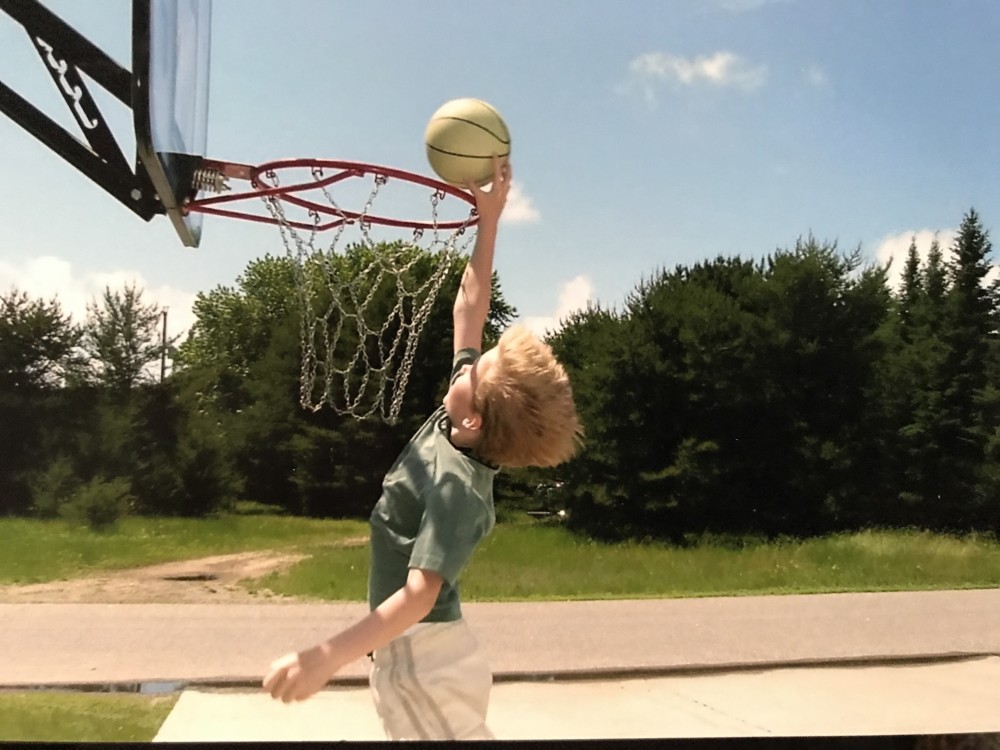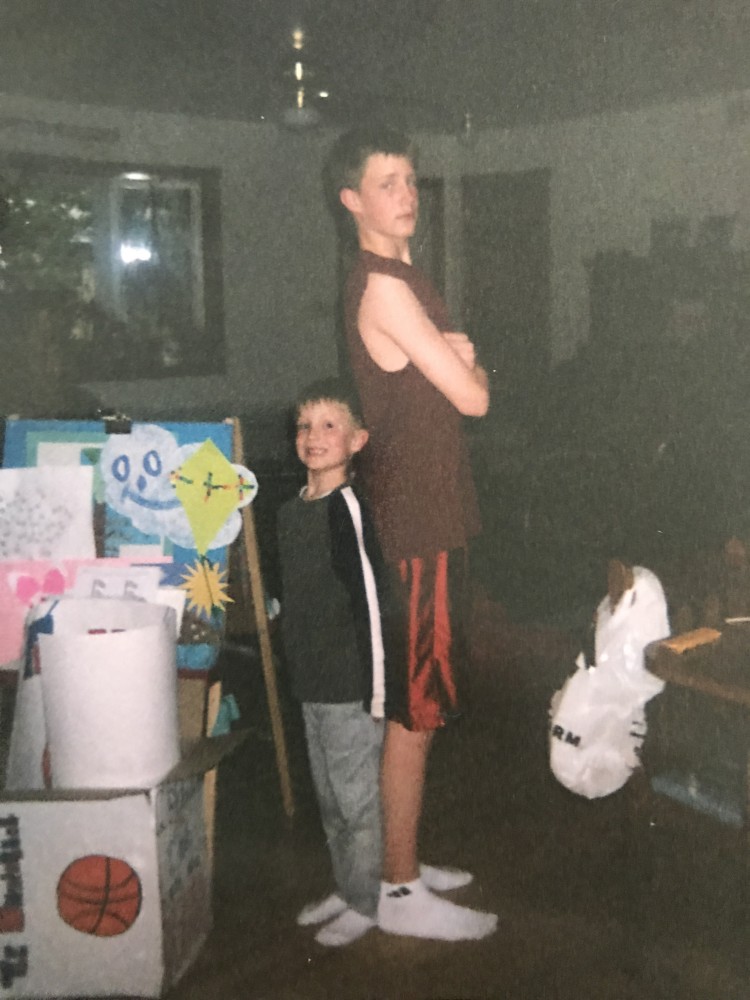Landing Page
Special Projects
This story is part of a series of specially designed stories that represents some of the best journalism The Post has to offer. Check out the rest of the special projects here.


PROVIDED VIA DEBRA GOLLON
02.15.18
Nothing could stop James Gollon from watching his brother Jakob play in the NCAA Tournament.
It was bad enough he had to stay back in Wisconsin for an Amateur Athletic Union, or AAU, tournament while his family attended the game in Raleigh, North Carolina. He couldn’t sit in class with Jakob scheduled to tip off against Duke at 12:15 p.m.
James filled out two brackets: one with his mind, the other his heart. The latter predicted a national championship for the Mercer Bears.
So James took his laptop into the technicians’ lounge at Pacelli High School and set up a stream. But the technicians kicked him out for skipping class. James decided he’d had enough, so he left the building and watched the game at a local Buffalo Wild Wings instead.
“Get out of here,” James said. “I’m not going to miss that. I don’t know why they didn’t just let me watch it in school.”
James’ stubbornness paid off. Instead of sitting in class, he watched his brother lead No. 14 seed Mercer with 20 points en route to a 78-71 upset of No. 3 seed Duke.
The phone James shared with his mother overflowed with congratulatory texts. Some from his friends, some from his mother’s colleagues.
James knew his brother best through a screen in those days. Because of Jakob’s two medical redshirts and mandatory summer school, he almost never came home during his six-year stint at Mercer. Jakob came home for Christmas one time in six years. Their seven and-a-half year difference never felt wider than during Jakob’s college days.
They talked on the phone about basketball and their respective surgeries (James had surgery on his hip in high school), but they never saw each other.
All the more reason why Jakob called James before anyone else to celebrate.
James recalls joyously shouting over the phone. Jakob remembers connecting with his little brother.
“The interaction I had with (James) was probably more special than with anyone else,” Jakob said. “When people say, ‘Mama, I made it,’ it was kind of like that, except it was brother to brother.”
James and Jakob grew up seven years apart, but they were always together. James made sure of it.
James, who is now a redshirt sophomore for Ohio, followed Jakob and his friends everywhere. Video games, sports, late night chats around the campfire — James was there.
Jakob’s friends treated him like their own little brother. If James was bothering them, they would tell him. More accurately, they would bully him.

Provided via Debra Gollon
When James attended a track meet with his brother’s crew in fourth grade, Jakob’s friend picked James up by the ankles and shook him like he expected something to fall out.
James bawled.
“We gave him enough s--- where he never bothered us,” Jakob said.
James never flinched. He figured out how to hang around his brother’s high school basketball team by becoming the waterboy. And he followed at Jakob’s heels so often that people called them both Jake.
Middle sister Jordan took notice of the two Jakes and became jealous. She tried her own ways to fit in.
She walked around in her brothers’ shoes and baggy jerseys. She tried basketball in an attempt to get closer to her brothers, but she gravitated toward gymnastics and volleyball, which she ended up playing at Mercer, too.
As a result, she didn’t share the same bond as her basketball-loving brothers.
“At times, I wanted to play basketball just to be able to get closer to them,” Jordan said. “I wanted to be like, ‘Hey, let’s go shoot around in the driveway.’ I wanted to enjoy that so much. But it just wasn’t the sport for me.”
Jordan earned her one-on-one time with James after Jakob went to college. But James missed his older brother during the time he needed him the most.
He was 10 or 11 when Jakob left for college. All the brotherly advice he needed — how much cologne to wear, how to hide secrets from Mom and Dad, what to say to a girl you like, how to shave — left when Jakob did.
“I spent so much time with him when I was younger,” James said. “It was— I don’t want to say devastating when he left, but it was just different.”
Jakob had options after leaving Mercer. He thought about playing overseas, but an MRI on his knee revealed the need for surgery.
He received coaching offers from all over the country, including a head coaching position at a community college in Montana. He rejected every one, except for a volunteer position at the University of Wisconsin-Stevens Point.
He could live at home that way. He basically hadn’t see his family in six years. He’d never seen James play basketball. Though his long absence was out of his control, Jakob felt guilty.
“I had been gone for so long and wanted to reconnect with James,” He said. “To some degree, I feel like I had abandoned the family going (to Mercer).”
A lot changed over six years. James matured, and Jakob stayed isolated. They needed time to get used to each other again.
“When he got back, we didn’t know each other as well as we should for brothers,” James said.
To rectify that issue, Jakob coached for free under the coach with the most wins in Wisconsin-Stevens Point history, Bob Semling, under one condition: On nights when James played, Jakob had to be sent on “recruiting trips.”
He lived in his parents’ basement at 24.
“Which sucked,” he said.
But he also transformed his brother from a fringe Division I prospect into a scholarship athlete. And they reforged their inseparable bond in the process.
James received two Division I offers before his senior season: Idaho State and Army. His hip surgery hindered his recruitment. He knew he needed a breakout season to draw attention.
Luckily for him, Jakob had keys to the Wisconsin-Stevens Point practice gym.
Throughout the summer of 2014, the Gollon brothers woke up early to workout. After James finished practicing after school and Jakob finished coaching practice in the evening, they met up and crafted the player James is today.
First, dribbling drills: a Chris Paul between-the-legs drill, the spider drill and stationary dribbling with one and two hands.
Then, shooting drills: James started seven feet from the rim and Jakob passed him the ball. Then James’ job became to finish over his brother at the rim.
“Make 25,” Jakob said.
Jakob would throw James an outlet pass, and James needed to dribble around a screen and make the pull-up jumper.
“Make 15,” Jakob said.
They watched film, talked about basketball and repeated their montage every day, not usually returning home until 8 or 9 p.m.
“It’s almost like a scene out of a movie,” Jakob said. “I’m getting goosebumps just thinking about it.”
Jakob realized he and his brother shared the same drive and the same passion. They were both disciplined and goal oriented. For people who hadn’t spent time together in over a decade, they had a lot in common — almost like they were brothers.
“It was a special time because I realized we wound up being exactly the same person,” Jakob said.
They spent so much time together that their mother, Debbie, enjoyed when one was too busy for the other.
Jakob had been gone for six years. James was about to leave for at least four. She needed her own quality time.
“I’m one the worst moms in terms of empty-nest syndrome,” Debbie said. “I have a hard time letting go.”
James looked to his brother for help to become a Bobcat. After suffering multiple surgery-requiring injuries, he enlisted Jakob’s help again to remain one.
James sat out most of his first two seasons at Ohio due to shoulder and hip injuries. He had surgery on both that kept him out the entirety of last season.
But he wasn't worried — Jakob set the example of how to come back from injury. Jakob came back and made the NCAA Tournament. Jakob came back and beat Duke. Jakob would help him through this.
But what if James wasn’t Jakob? Jakob feared that might be the case. He agonized over his brother’s predicament.
“I had this sick feeling in my stomach that he might not be as fortunate as I was,” Jakob said. “What if he never got healthy?”
But those thoughts came to him before he saw James for the first time after the surgeries. James knew he would be back because he would do everything he could to come back.
Jakob calls his brother’s mentality “healthy ignorance.”
He compares James to a child swinging a baseball bat for the first time: No matter how many times James swings and misses, he’ll keep trying to hit the ball. Most adults will swing and miss once and never pick the bat up again.
James believes he’ll hit the ball, too, just like he believed he’d return from his injuries.
Jakob marveled at the confidence his brother displayed during rehab — sure of himself, but without an ego attached.
James will tell you he gets it from his older brother. He’ll tell you he’s learned a lot from Jakob, actually.
James calls him a second father figure. Coach Saul Phillips says it’s obvious that James’ brother is his idol.
But somewhere along the line, Jakob starting learning from James. James started teaching Jakob, whether he knew it or not.
People used to call James and Jakob the same name. Now people think they’re the same person.
They use the same words without ever speaking them to each other. Not only can they tell when their brother has bad days, they usually have them at them same time. It’s twin telepathy, but seven years apart.
Jakob sees at least one difference, though.
“I’m happy to say that he’s like me in a lot of ways,” Jakob said. “But he’s the 2.0 version. He’s the update. He’s the patch. In many ways, I look up to him.”
BackLanding Page
This story is part of a series of specially designed stories that represents some of the best journalism The Post has to offer. Check out the rest of the special projects here.